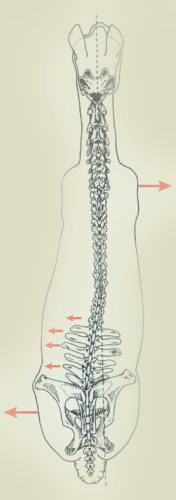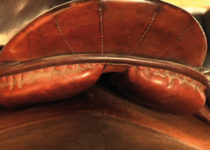Lameness Causes Saddle Slip? Or Vice Versa?
©2015 courtesy of Saddlefit 4 Life® and with thanks to Murielle Price, once of our Certified Equine Ergonomists working in California who is actually sending a version of the blog as a letter to the editor of “USDF Connections” magazine.


These thoughts are in response to a recent article appearing in several magazines concerning the international conference put on by the Saddle Research Trust with one of the topics being the interaction between equine lameness as a cause for saddle slip. Although my experiences and personal examination of this phenomenon seems to indicate that the causative factors are actually the other way around (i.e., saddle slip causes lameness issues), there were several good points coming from this conference that are consistent with what I know and teach about saddle fitting:
- Saddle fit must include fitting the rider correctly
- Saddle slip is due to “asymmetries of the horse, the rider or the saddle”
- Rider crookedness is more likely a result than a cause of saddle slip
- More frequent (than annually) evaluations may be needed because a horse’s back changes with seasons, body weight, and workload
- Riders ride (foot pronation or not) as they walk (we ride as we are, so it would follow we ride as we walk too)
- Riders need good core strength and should be symmetrical in order to make their horses symmetrical
- Early detection of saddle slip is important
What I don’t necessarily agree with:
- Lameness is being blamed for saddle slip (if your saddle is slipping, call a vet for a lameness exam), rather than what we see in saddle fitting, which is that natural asymmetry in the horse causes ‘saddle slip’, which in turn causes the saddle to ride on reflex points (sometimes resulting in negative behavior). This then causes lameness because the horse hollows its back and cannot engage its hind or lift its front end, and therefore is being ridden on the forehand (and is more likely to remain asymmetrical and have joint issues.) If a symmetrical saddle is used on an asymmetrical horse, the larger and more rearward shoulder (usually the left one) causes the saddle to twist and/or rotate toward the side of the smaller and more forward shoulder (usually the right). The gullet plate of the saddle has to fit the profile of the horse’s shoulder-wither area – matching it in width and angle. If a horse is asymmetrical and the saddle fitter is able to open the gullet plate on the larger side to accommodate the larger shoulder, the saddle will stop slipping (twisting/rotating) and won’t ride on the horse’s spine. The rider can now be straight, and if the riding is correct the horse will bring its back up and use it, engage his hind end and begin to lift its front end up. Now there is finally a chance for the rider to help make the horse straighter, and when the horse is measured and found to be even, the gullet plate is brought back to symmetrical, where it can stay as long as the horse remains even.
- By using the term ‘saddle slip’, no differentiation is being made between a saddle twisting (yaw), and a saddle rotating (roll). While both are undesirable because either way a panel is too close to the spine and spinal ligaments, a saddle that twists because one of the horse’s shoulders is larger and farther back than the other really causes problems when the rear portion of that panel rides on the spine, and often we see saddles that are too long, so that incursion onto the spine is behind the 18th vertebra onto the lumbar area. More often than not, asymmetry causes both a twisting and a rotation.
-

This saddle has slipped to the right and is lying on the vertebra on the left. The gullet channel is obviously too narrow for the horse as well. The article recommends that riders watch for rub marks on hair coat, dry spots within sweaty areas, wavy hair as signs that something is wrong. While these can signal a saddle fit issue, by the time those signs are visible, too much damage may already have been done. What about all the behavioral signs that the horse is trying to tell us that the saddle does not fit? Horses which are resistant, hollow, head-up, tail-swishing, girthy, have gait abnormalities, are ‘cold-backed’, rushing, bucking, stumble frequently, and have overall poor work attitude are trying to tell us something and we should not wait until we see the physical signs that the saddle we are using is causing pain and dysfunction.
It is wonderful that this topic is being treated seriously and that studies are being devised to find out how best to help our equine partners. Empirical findings would greatly enrich this work. Would a conversation between the scientific and empirical sides of the coin not benefit everyone?
I welcome your thoughts!
